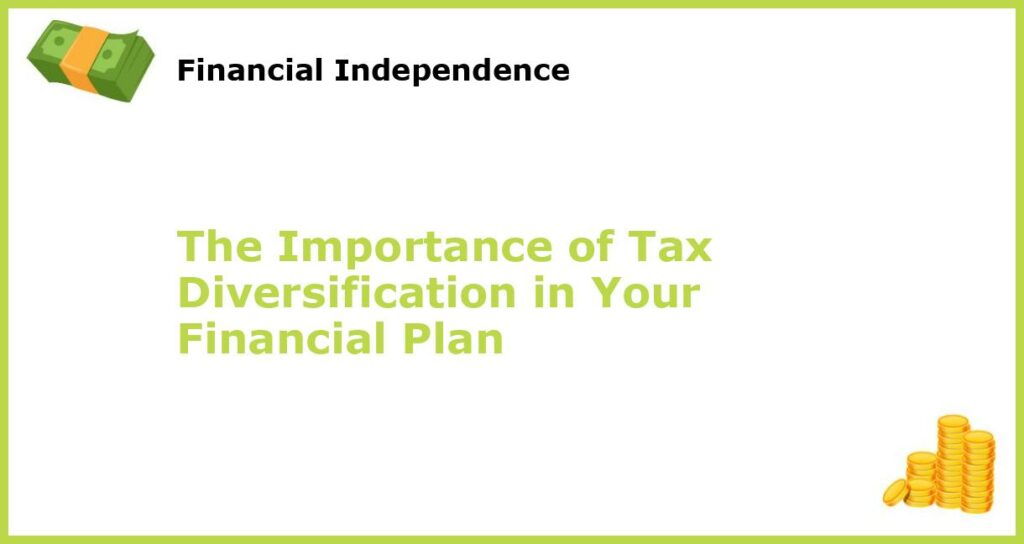Tax diversification is like having a piece of chocolate cake with a scoop of vanilla ice cream on the side – each of them delicious on their own but even better together. When it comes to managing your finances, tax diversification is an essential component. It is the process of spreading your investments across different types of tax structures, such as taxable accounts, tax-deferred accounts, and tax-free accounts. By doing so, you can minimize the amount of taxes you pay and potentially increase your wealth over time.
Maximizing Your Wealth

When you invest your money, the returns you receive are typically subject to taxes. These taxes can take a significant chunk of your investment returns, reducing your overall wealth over time. By diversifying your investments across different tax structures, you can minimize the amount of taxes you pay and potentially increase your investment returns. For example, investing in tax-free municipal bonds can provide you with tax-free investment returns. By including them in your portfolio, you can receive higher after-tax returns than you would from traditional taxable bonds.
Balancing Your Portfolio

A diversified portfolio gives you the flexibility to balance your investments based on current market conditions, your financial goals, and your income tax bracket. For example, if you expect taxes to increase in the future, you can adjust your portfolio to focus on tax-efficient investments, such as Roth IRA or Roth 401(k) accounts. Additionally, if you are in a higher income tax bracket, you might consider investing in tax-free municipal bonds while still capturing the returns of the stock market. By diversifying across a broad range of assets and tax structures, you can spread your risk, potentially enhancing your return and tax efficiency while reducing volatility.
Reducing Your Risk

There is no such thing as a risk-free investment, but diversification can help reduce your overall investment risk. If one sector or asset class fails, you have other investments to fall back on. Diversification also allows you to invest your money across a range of assets, such as stocks, bonds, and real estate, reducing your overall volatility risk. For example, if the stock market crashes, your bond holdings might increase in value or remain stable, offsetting the losses in your stock holdings.
Staying Prepared for Changes

Tax laws and regulations can be unpredictable, and new changes can have a significant impact on your investments. By diversifying your portfolio, you can stay prepared for any tax law changes that may come your way. You can adjust your investment strategy accordingly to minimize any tax implications and ensure that you continue to maximize your after-tax returns. For example, if lawmakers eliminate certain tax deductions or increase tax rates, you can adjust your investments to lower your tax burden.
Benefiting from Different Tax Rates
If you have a mix of taxable and tax-free investments, you can benefit from different tax rates. Some investments may be taxed at a higher rate than others, such as short-term capital gains. By taking advantage of these differences, you can minimize your overall tax burden. For example, let’s say you need to withdraw $10,000 from your retirement account. If you had invested all your money in a traditional IRA, you would owe taxes on the entire withdrawal amount. However, if you had diversified your investments across traditional IRA, Roth IRA, and taxable accounts, you could withdraw $5,000 from your tax-free Roth IRA and $5,000 from your taxable account, potentially minimizing your overall tax burden.
Planning for Retirement
Diversifying your retirement accounts across different tax structures can help you maximize your retirement income. This may include investing in a combination of traditional IRA, Roth IRA, and other retirement accounts. By doing so, you can minimize your taxes during your retirement years, potentially enhancing your income and increasing your after-tax returns. Additionally, tax diversification can help you better manage your required minimum distributions (RMDs) once you reach age 72. By having multiple options, you can optimize your RMDs to minimize your tax burden and maximize your retirement income potential.
Flexibility in Withdrawals
By diversifying your investments, you have more flexibility when it comes to withdrawing money from your accounts. You can choose to withdraw from tax-free or taxable accounts based on your current financial needs. For example, if you have a year where you expect to have a high tax bill, you may choose to withdraw money from a tax-free account to minimize your overall tax burden. Alternatively, if you have a year where you expect to have a lower tax bill or even a net loss, you can choose to withdraw money from a taxable account to offset capital gains.
Minimizing Tax Liability
With a diversified portfolio, you can minimize your tax liability by offsetting taxable gains with losses from other investments. This strategy is known as tax-loss harvesting and is an effective way to reduce your overall tax bill. For example, let’s say you have an investment in one company that has seen losses, while you have gains in another company. By selling the losing investment, you can offset your potential capital gains tax liability on the profitable investment. This strategy can help capture tax savings in the current year and increase your overall after-tax returns.
Adjusting for Your Life Stage
Tax diversification is not a one-time process. As you progress through different life stages, your financial needs and goals will change. It is essential to adjust your tax diversification strategy accordingly to maximize your wealth and minimize your tax burden. For example, if you have a baby and move to a single-income household, you may want to invest more in tax-deferred accounts to reduce your current tax burden. Alternatively, if you decide to start a business, you may want to invest more in taxable accounts to take advantage of potential business tax deductions.
Taking Action Now
If you have not yet diversified your investments across different tax structures, now is the ideal time to start. Speak to a financial advisor about tax diversification and how it can benefit your financial plan. By working together, you can develop a diversified investment strategy to help you maximize your wealth, reduce your risk, and minimize your tax liability. Just like having your cake and eating it too!







